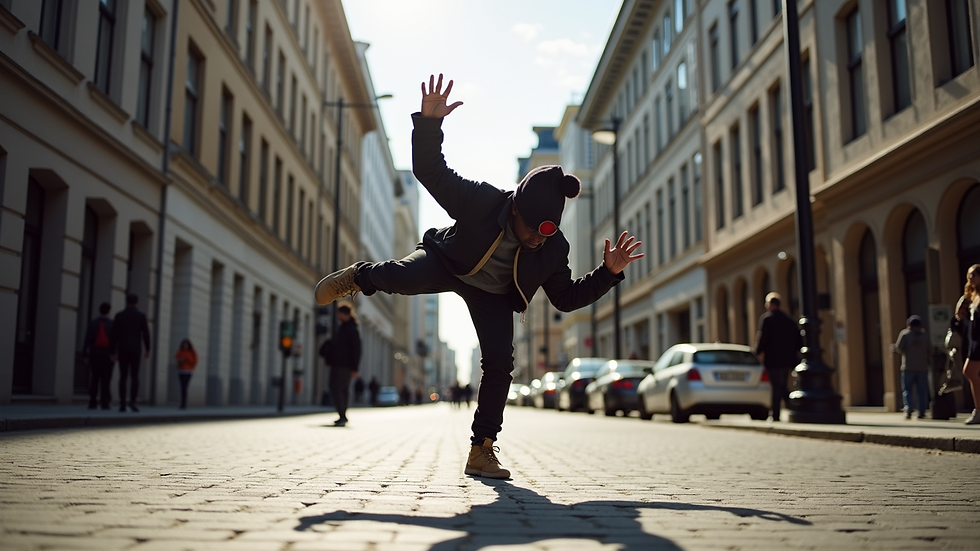Explore Tunisia's Urban Dance Culture
- Oct 8
- 4 min read
Tunisia's vibrant urban landscape is not only rich in history and tradition but also alive with a dynamic street dance culture. This culture is a powerful form of expression for many young Tunisians, blending global influences with local creativity. The streets, parks, and community centers across Tunisian cities serve as stages where dancers showcase their skills, passion, and stories through movement.
The Rise of Street Dance Culture in Tunisia
Street dance culture in Tunisia has grown significantly over the past decade. It started as a grassroots movement, with young people gathering in public spaces to dance, share techniques, and compete. Today, it has evolved into a recognized art form supported by dance schools, festivals, and competitions.
Several factors have contributed to this rise:
Youth Engagement: Young Tunisians use street dance as a way to connect, express themselves, and escape daily challenges.
Social Media Influence: Platforms like Instagram and YouTube have helped dancers share their performances globally, inspiring others and attracting attention to the local scene.
Cultural Fusion: Tunisian street dance incorporates elements from hip-hop, breakdancing, popping, locking, and traditional Tunisian music and rhythms.
This fusion creates a unique style that reflects Tunisia's diverse cultural heritage and modern urban life.

What is also known as street or urban dance?
Street dance, also known as urban dance, refers to dance styles that originated outside of traditional dance studios, often performed in informal settings like streets, clubs, and parks. These styles include hip-hop, breakdancing, popping, locking, and krumping, among others.
In Tunisia, street dance is more than just a form of entertainment. It is a social movement that promotes community, creativity, and resilience. Dancers often form crews or groups that support each other, organize events, and participate in battles or competitions.
Key characteristics of street dance include:
Improvisation - Dancers often freestyle, creating spontaneous movements.
Battles - Competitive dance-offs that showcase skill and creativity.
Community - A strong sense of belonging and mutual respect among dancers.
Cultural Expression - Incorporation of local music, fashion, and attitudes.
These elements make street dance a vibrant and evolving culture that resonates deeply with Tunisian youth.

The Role of Dance Schools and Festivals
The growth of Tunisia's street dance culture has been supported by the establishment of dance schools and the organization of festivals. These institutions provide training, resources, and platforms for dancers to develop their skills and gain exposure.
Dance Schools: Many urban dance schools in Tunisia offer classes in various street dance styles. They focus on technique, choreography, and performance skills. These schools also foster a sense of discipline and teamwork.
Festivals and Competitions: Events like dance battles, hip-hop festivals, and cultural showcases attract dancers from across the country and beyond. These gatherings celebrate the art form and encourage cultural exchange.
For example, the annual Tunis Hip-Hop Festival is a major event that highlights street dance alongside music, graffiti, and other urban arts. It draws large crowds and provides opportunities for dancers to network and collaborate.

How to Get Involved in Tunisia's Street Dance Scene
If you are interested in exploring Tunisia's street dance culture, there are several ways to get involved:
Join a Dance School: Enroll in classes to learn the basics and improve your skills. Many schools welcome beginners and offer workshops.
Attend Events: Participate in or watch local dance battles, festivals, and community gatherings. These events are great for meeting dancers and experiencing the culture firsthand.
Practice Regularly: Street dance requires dedication and practice. Find a group or crew to train with and exchange ideas.
Use Online Resources: Follow Tunisian dancers and groups on social media. Platforms like urban dance provide valuable information and inspiration.
Respect the Culture: Understand the history and values behind street dance. Respect fellow dancers and the community.
By engaging actively, you can become part of a vibrant and supportive culture that celebrates creativity and self-expression.
The Future of Street Dance Culture in Tunisia
The future of Tunisia's street dance culture looks promising. As more young people embrace this art form, it continues to evolve and gain recognition both locally and internationally. The integration of technology, such as virtual workshops and online battles, is expanding access and participation.
Moreover, street dance is increasingly seen as a tool for social change. It promotes positive values like teamwork, discipline, and cultural pride. Organizations and local governments are beginning to support street dance initiatives as part of youth development programs.
To sustain this momentum, it is important to:
Encourage collaboration between dancers, schools, and cultural institutions.
Provide funding and resources for events and training.
Promote street dance as a legitimate art form in media and education.
Foster inclusivity and diversity within the dance community.
With these efforts, Tunisia's street dance culture will continue to thrive and inspire future generations.
Exploring Tunisia's street dance culture reveals a vibrant world where tradition meets modernity through movement. Whether you are a dancer, enthusiast, or curious observer, this culture offers a unique window into the spirit and creativity of Tunisia's youth. Dive in, connect, and experience the energy of street dance firsthand.



Comments